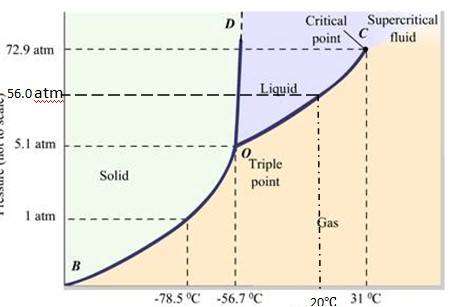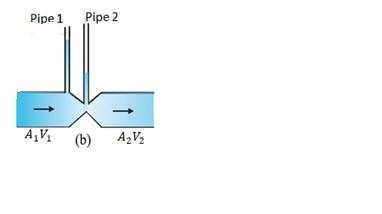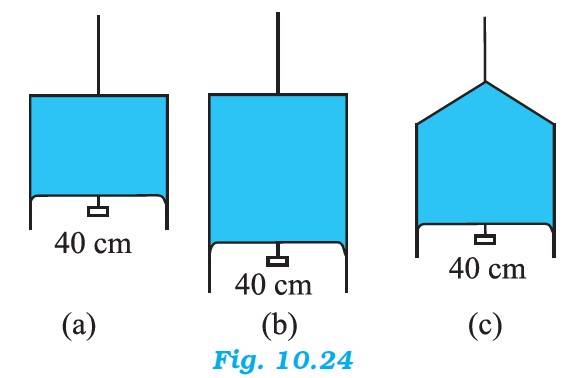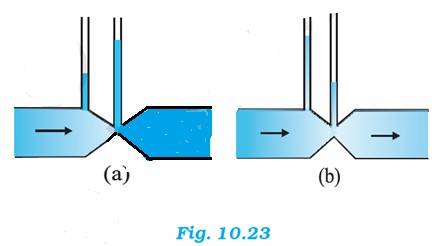physics ncert solutions class 11th
Get insights from 952 questions on physics ncert solutions class 11th, answered by students, alumni, and experts. You may also ask and answer any question you like about physics ncert solutions class 11th
Follow Ask QuestionQuestions
Discussions
Active Users
Followers
New answer posted
5 months agoContributor-Level 10
Soap bubble radius, r = 5.0 mm = 5 m
Surface tension of the soap bubble, S = 2.50 N/m
Relative density of soap solution = 1.20, hence density of soap solution, = 1.2 Kg/
Air bubble formed at a depth, h = 40 cm = 0.4 m
1 atmospheric pressure = 1.01 Pa
Acceleration due to gravity, g = 9.8 m/
We know, the excess pressure inside the soap bubble is given by the relation:
P = = Pa = 20 Pa
Hence, the excess pressure inside the air bubble is given by the relation, P' = = 10 Pa
At a depth of h, the total pressure inside the air bubble = Atmospheric press
New answer posted
5 months agoContributor-Level 10
11.21

(a) The P-T phase diagram for CO2 is shown here. O is the triple point of the CO2 phase diagram. This means that at the temperature and pressure corresponding to this point, the solid, liquid and vaporous phases of CO2 exists in equilibrium.
(b) The fusion and the boiling points of CO2 decreases with a decrease in pressure.
(c) The critical temperature and critical pressure of CO2 are 31 72.9 atm respectively. Even if it is compressed to a pressure greater than 72.9 atm, CO2 will not liquefy above the critical temperature.
(d) It can be concluded from the P-T phase diagram of CO2 that:
CO2 is gaseous at -70 , under 1 atm pr
New answer posted
5 months agoContributor-Level 10
Radius of the mercury droplet, r = 3.00 mm = 3 m
Surface tension, S = 4.65 N/m
Atmospheric pressure, = 1.01 Pa
Total pressure inside the mercury drop = Excess pressure inside mercury + Atmospheric pressure
= + = + 1.01 = 1.01310 Pa
Excess pressure inside mercury = = = 310 Pa
New answer posted
5 months agoContributor-Level 10
The length of the liquid film supported by the weight, l = 40 cm = 0.4 m
The weight supported by the film, W = 4.5 N
Since a liquid film has two free surfaces,
Surface tension = = = 5.625 N/m
In all 3 figures, the liquid is the same, temperature is also the same. Hence the surface tension in (b) and (c) are also going to be the same, with the value of 5.625 N/m and weight supported in each case is also going to be the same, since length of the film is same.
New answer posted
5 months agoContributor-Level 10
The weight that the soap film supports, W = 1.5 N
Length of the slider, l = 30 cm = 0.3 m
A soap film has two free surfaces, hence total length = 2l = 0.6 m
Surface tension, S= = = 2.5 N/m
New answer posted
5 months agoContributor-Level 10
11.20 According to Newton’s law of cooling, we have
= K(T -
Temperature of the surroundings =
K is a constant
The temperature of the body falls from 80
Integrating equation (i), we get
The temperature of the body falls from 60
Hence, we get:
Equating equations (ii) and (iii), we get,
Hence, the time taken to cool the body from 60
New answer posted
5 months agoContributor-Level 10
Area of cross-section of the spray pump,
Number of holes, n = 40
Diameter of each hole, d = 1 mm = 1
Radius of each hole, r = d/2 = 0.5
Area of cross-section of each hole, a =
Total area of 40 holes,
Speed of liquid inside the tube,
Speed of ejection of liquid =
According to law of continuity, we have
= 0.637 m/s
New answer posted
5 months agoContributor-Level 10
Take the case given in figure (b)

From the law of continuity, we have
When the area of cross-section in the middle of the venturimeter is small, the speed of the flow of liquid through this part is more. According to Bernoulli's principle, if speed is more, the pressure is less. Pressure is directly proportional to height, hence the level of water in pipe 2 is less. Therefore, figure (a) is not possible.
New answer posted
5 months agoContributor-Level 10
Speed of the wind on the upper surface of the wing,
Speed of the wind on the lower surface of the wing,
Area of the wing, A = 2.5
Density of air,
According to Bernoulli's theorem, we have the relation:
(
The pressure difference provides lift to the aeroplane
Lift on the wing = (
New answer posted
5 months agoContributor-Level 10
11.19 (a) A body with a large reflectivity is a bad absorber. A bad absorber will in turn be a poor emitter of radiations.
(b) Brass is a good conductor of heat, when one touches a brass tumbler, heat is conducted from the body to the brass tumbler easily. Hence, the temperature of the body reduces to a colder value and one feels cold.
On the other hand, wood is a poor conductor of heat. Very little heat is conducted from the body to the wooden tray. Resulting in negligible drop in body temperature.
Thus a brass tumbler feels colder than a wooden tray on a chilly day.
(c) Black body radiation equation is given by:
E =
Taking an Exam? Selecting a College?
Get authentic answers from experts, students and alumni that you won't find anywhere else
Sign Up on ShikshaOn Shiksha, get access to
- 65k Colleges
- 1.2k Exams
- 686k Reviews
- 1800k Answers


